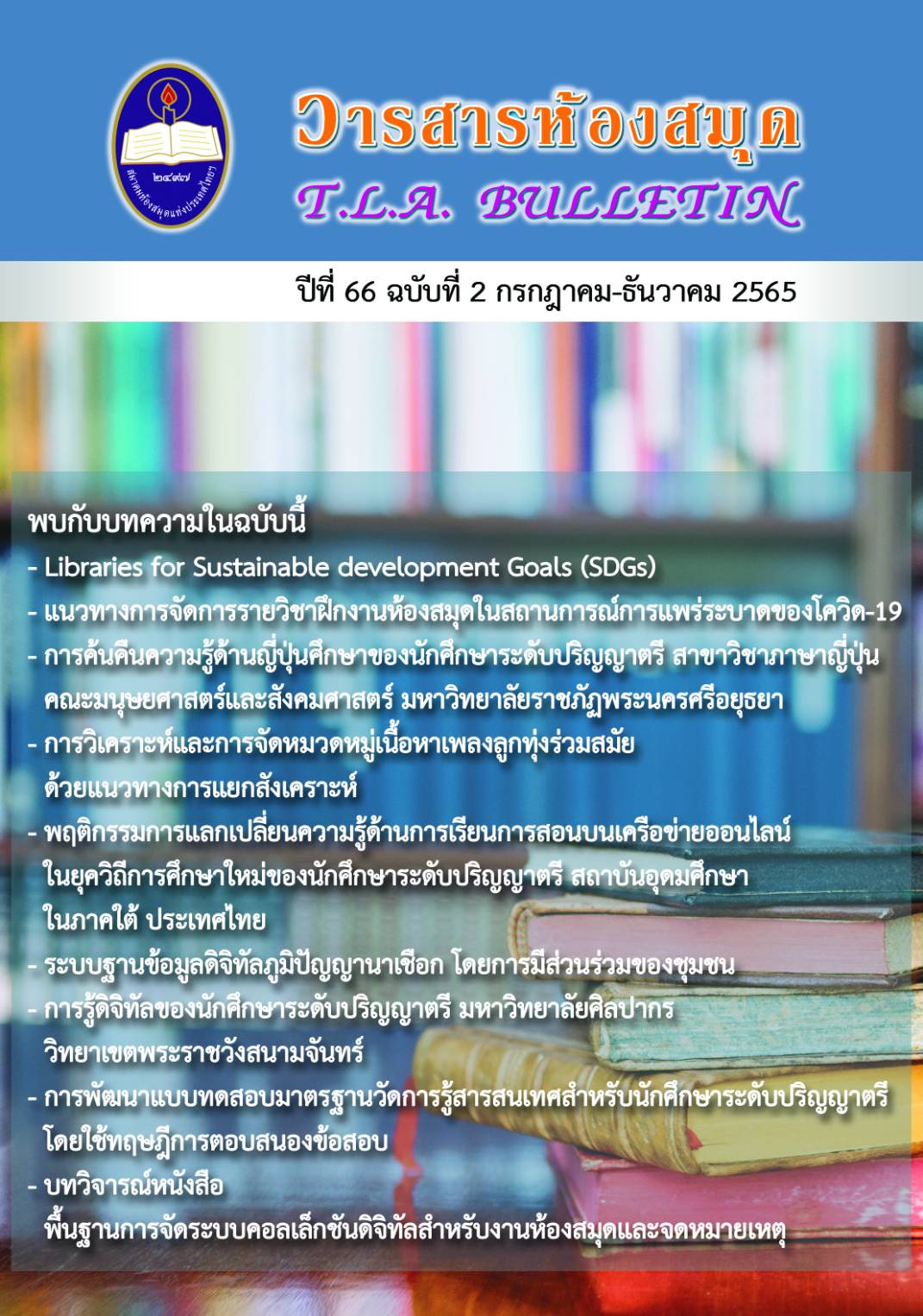Development of Standard Information Literacy Test for Undergraduate Students Through Item Response Theory
Keywords:
Standardized test, Information literacy, Item response theoryAbstract
Abstract
The objective of this research was to develop a standardized test to measure students’ information literacy using Item Response Theory (IRT), Senior students from the regular semester of the academic year 2021 were chosen as the sample group, which was divided into three groups. Group I, it was used to double-check the multiple-choice questions, language compatibility, and test timing. A total of five participants were selected using a purposive sampling. Group II, 30 students chosen purposively were employed for testing the tool to analyze the quality of item through Classical Test Theory (CTT) and Group III, 500 students obtained from the single-stage cluster sampling were adopted to determine the quality of test via Item Response Theory (IRT). The research tool was the standardized test that measure the information literacy according to the information literacy standards of Association of College and Research Library-ACRL. It was revealed that a total of 41 quizzes of multiple-choice question were obtained with the power of discrimination (a), difficulty (b) and guess (c) ranging from 0.53 to +2.39 (a), -1,12 to +2.08 (b) and 0.07 to 0.29 (c). The test information (θ) was slightly increasing (-0.9 to 0.1), implying that this test was suitable for scaling the students who were moderate level. The predicted reliability (rtt) was 0.862.
Keywords: Standardized test, Information literacy, Item Response Theory
Downloads
References
American of College and Research Libraries. (2000). Information literacy competency standards for higher education. Retrieved from http://www.ala.org/ala/acri/acristandards/standards.pdf.
Bloom, B.S. (1984). Taxonomy of educational objectives, the classification of educational goals : Handbook I. Mckay.
Cameron, L., Wise, S.L. & Lottridge, S. M. (2007, May). The development and validation of the information literacy test. College and Research Libraries. 68(3), 229-236. Retrieved from http://www.researchgate.net/publication
Pharattakul, C. (1975). Measurement techniques (6th ed.). Watanapanit Printing & Publishing. [In Thai]
Pharattakul, C. (n.d.). Norms. in Measuring and evaluating education. Srinakharinwirot University. [In Thai]
Ngernpoolsap, D., Sacchanand, C., Kheokao, J., & Premsmit, P. (2018, January-June). The development of information literacy skill test for undergraduate students in journalism. Journal of Library and Information Srinakharinwiirot University, 11(1), 176-190.
Horton, F.W., Jr. (2008). Understanding information literacy: A power. UNESCO.
Jamornman, U. (1996). Psychological measurement theory. Funny Publishing. [In Thai]
Kanjanawasee, S. (2020). Modern test theories (15th rev. ed.). Chulalongkorn University Printing House. [In Thai]
Kaplowitz, J. R. (2014). Designing information literacy instruction: The teaching tripod approach. Lanham, MD: Rowman & Littlefield.
Khaimook, K. (2001). Development criteria for selecting answers appropriate to the test takers’ abilities. (Doctoral dissertation). Chulalongkorn University.
Leichner, N., Peter, J., Mayer, A. and Krampen, G. (2013, 4 April). Assessing information literacy among German psychology students. Reference Services Review. 41(4), 660-674. Doi 10.1108/RSR-11-2012-0076.
Lord, F.M. (1980). Application of item response theory in practical testing problem. Low-Rence Eribaum Associates.
Manowaluilou, N. (2008). The importance of undergraduate’s computer competency and information literacy skills: Marketing faculty’s perception perspective in Thailand. (Doctoral dissertation). University of Missouri-Columbia, Missouri.
Phatthiyathani, S. (2003). Educational measurement (4th ed.). Prasan Printing House. [In Thai]
Pibulsongkram Rajabhat University. (2021). Student information, academic year 2021. Education Services Division, Pibulsongkram Rajabhat University. [In Thai]
Rangchaikul Wiboonsri, Y. (2011). Measurement and creating an achievement test (10th ed.). Chulalongkorn University Printing House. [In Thai]
Saiyot, L. & Saiyot, A. (1996). Learning measurement techniques. Suwiriyasan. [In Thai]
Saiyot, L. & Saiyot, A. (2000). Statistics for research (3rd ed.). Suwiriyasan. [In Thai]
Singh, A. B. (2005). A report on faculty perceptions of students’ information literacy competencies in Journalism and Mass Communication Program: The ACEJMC survey. College & Research Libraries, 66(2), 294-310.
Sriphan, K. (2010). Development of standard test of information literacy skills for Chiang Mai University students. (Master thesis). Chiang Mai University, Thailand.
Sriphan, K. (2011). Development of standard assessment of information literacy skills for Chiang Mai University students. Journal of Human Science, 12(2), 106-112. [In Thai]
Srisuk, K. (2009). Research methodology. Krongchang Printing House. [In Thai]
Sunaga, K. (2016). The Survey of the information literacy among students and teachers. Education Reform Journal. 1(2), 49-55.
Wannarat, W. (1997). Standard test. Srinakharinwirot University. [In Thai]
Warm, T. A. (1979). A Primer of Item Response Theory. Coast Guard Institute.
Downloads
Published
How to Cite
Issue
Section
License
Copyright (c) 2022 TLA Bulletin (Thai Library Association)

This work is licensed under a Creative Commons Attribution-NonCommercial-NoDerivatives 4.0 International License.



